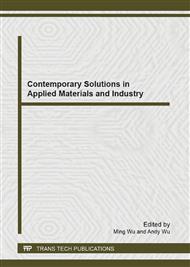[1]
Matthias Weidlich, Mathias Weske, Jan Mendling. "Change Propagation in Process Models using Behavioural Profiles", IEEE International Conference on Service Computing, 2009.
DOI: 10.1109/scc.2009.58
Google Scholar
[2]
Jie Hou, Shijun Liu, Xiangxu Meng. "Research on the UI Integration Architecture of Service System", International Conference on Communications, 2008.
Google Scholar
[3]
Nianjun Zhou, Liangjie Zhang. "A Graph Theory Based Impact and Completion Analysis Framework and Applications for Modeling SOA Solution Components", IEEE International Conference on Services Computing, 2008.
DOI: 10.1109/scc.2008.137
Google Scholar
[4]
Hassan Issa, Chadi Assi, Mourad Debbabi. "QoS-Aware Middleware for Web Services Composition- A Qualitative Approach", IEEE Symposium on Computers and Communications, 2006.
DOI: 10.1109/iscc.2006.135
Google Scholar
[5]
Andreas Wombacher. "Alignment of choreography changes in BPEL processes", IEEE International Conference on Services Computing, 2009.
DOI: 10.1109/scc.2009.11
Google Scholar
[6]
David Chen, Guy Doumeingts, Francois Vernadat. "Architectures for enterprise integration and interoperability: Past, present and future", Computers in Industry, 2008.
DOI: 10.1016/j.compind.2007.12.016
Google Scholar
[7]
Adina Sirbu, Jorg Hoffmann. "Towards Scalable Web Service Composition With Partial Matches", IEEE International Conference on Web Services, 2008.
DOI: 10.1109/icws.2008.69
Google Scholar
[8]
Yongsheng Ma, GangChen, Georg Thimm. "Change propagation algorithm in a unified feature modeling scheme", Computers in Industry, 2008.
DOI: 10.1016/j.compind.2007.06.006
Google Scholar
[9]
ZhifengGu, JuanziLi, BinXu. "Automatic Service Composition Based on Enhanced Service Dependency Graph", IEEE International Conference on Web Services, 2008.
DOI: 10.1109/icws.2008.68
Google Scholar
[10]
Xiaopeng Zhao, ZongyanQiu, ChaoCai, HongliYang. "A Formal Model of Human Workflow", IEEE International Conference on Web Services, 2008.
Google Scholar
[11]
JIAO YuChang, LIU ShiJun,Meng Xiangxu, Yang Chenglei, ASaaSI: an approved Architecture for SaaS Service Composition, CIDE2008
Google Scholar


